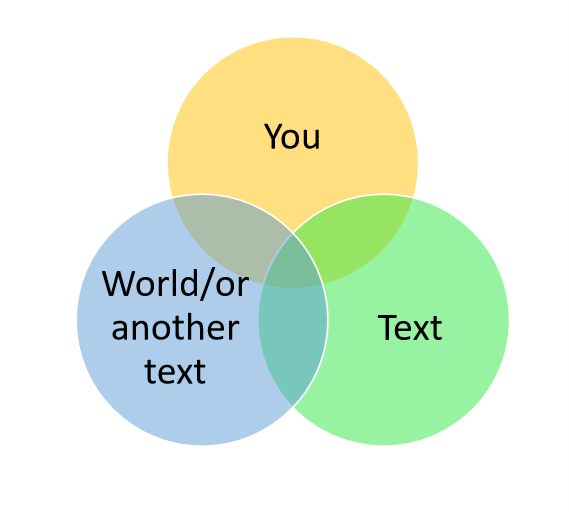3.4: Questioning Strategies
- Page ID
- 31324
Questioning Circles
The questioning circles are a graphical representation (a form of a Venn diagram) of three domains: You, the Text, and the World (or another text). When you create questions based on a domain, or a combination of domains, it can help you examine and think about an idea more deeply. This, in turn, can help you understand and think about your reading and help you develop your writing.
There are three levels of questions in this model:
Level 1 (Clear) Questions: These are about one domain only and can only be answered with a fact.
Level 2 (Shaded) Questions: These are questions about a combination of two domains and require interpretation and an opinion by the person who answers the question.
Level 3 (Dense) Questions: These questions combine all three domains. They require interpretation, and usually there is no one right answer. Level 3 questions make great essay questions!
The following figure is a graphic representation of the domains you would ask about when creating questions: you, the text, and another world or another text. Please note that a text can be anything you "read," from a class reading assignment, to a movie, etc.
Figure 3.3.1: Questioning Circle Domains
.jpg?revision=1)
Examples of Questioning Circle Questions
Level 1 questions can be answered with facts only.
- Level 1 question about you: Have you ever experienced xx?
- Level 1 question about the text: What was the setting in the text in Chapter x?
- Level 1 question about the world: How often does x occur in the world?
Level 2 questions combine two of the domains. They can only be answered with an opinion (an educated opinion).
- Level 2 question about you and the text: Do you think you would respond in the same way as (character) did if you were in that situation?
- Level 2 question about you and the world: What have your experiences in the world in relation to xxx been like?
- Level 2 question about the text and the world: Are (character’s) experiences in the book representative of how most people in the world experience this situation?
- Level 2 question about the text and another text: How do the characters in [novel] and [novel] react differently to similar situations?
Level 3 questions ask questions about a combination of all three domains. These questions cannot be answered definitively and generally require readers to compare ideas about issues that can't easily be answered.
Level 3 question about you, text, and the world: How do you think a person’s past experiences inform how they interact with people in situations such as those in which [characters] found themselves?
Contributors
CC LICENSED CONTENT, ORIGINAL:
- Revision, Adaptation, and Original Content. Provided by: Libretexts. License: CC BY-SA 4.0: Attribution.
This page was most recently updated on June 6, 2020.


